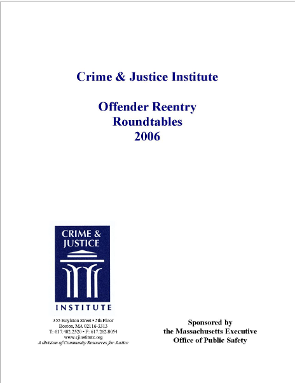
Dec. 15, 2006
Authors: Elyse Clawson, Leonard Engel, Meghan Howe, Cheryl Roberts, Jennifer Fahey, Kristin Collins
Sponsored by the Massachusetts Executive Office of Public Safety & Security (EOPSS), CJI completed a series of roundtable discussions that examined significant issues in offender reentry. Entitled the Crime & Justice Institute Reentry Roundtables, this project focused on three, distinct aspects of offender reentry, two of which culminated in large public events featuring moderated panels discussing the impact of offender reentry on high crime communities and the unique issues of female offenders in reentry. The third part of the project included original research on the hiring decisions of employers and a final report on the findings and recommendations of the Advisory Group.
Click here to read the full report.
Read further descriptions of the three reentry topics addressed:
Employment of Ex-Offenders: Employer Perspectives
Authors: Jennifer Fahey, Cheryl Roberts, Leonard Engel
To gain a better understanding of employers’ views about hiring ex-offenders, the Crime and Justice Institute (CJI) conducted a review of the national research literature and held a series of focus groups with employers in the greater Boston area. The report presents a summary of findings and recommendations.
For ex-offenders returning to the community after a period of incarceration, employment can make the difference between succeeding and returning to prison. Yet ex-offenders face significant barriers to employment, including employer attitudes toward individuals with criminal records, legal barriers, educational and financial obstacles, substance abuse and health issues, and lack of stable housing.
Victims & Communities Impacted by Reentry: Perspectives on Offender Reentry
Authors: Leonard Engel, Meghan Howe
The opportunity to understand the complex issues of offender reentry and the impact on the communities to which they return with the goal of bringing key stakeholders together, led CJI to examine these issues and the innovative strategies involving community members in the reentry planning of the offenders. This effort culminated in a day-long roundtable discussion with a diverse group of people involved in one manner or another with reentry, victims and the community.
The residents of high-crime communities may or may not be the direct victims of crime, at least in the sense of qualifying for victim services, but they are victims of the criminality present in their neighborhoods. The communities in which they live are also where the majority of offenders return after incarceration. The residents of these communities must not only deal with the threats caused by the unending presence of criminality but must also bear the burden of absorbing the returning offenders; the previous victimizers. They have no control over the fact that the offender is returning and very little impact in the criminal justice process, including re-entry.
Women and Reentry: Foundations for Success
Authors: Meghan Howe, Kristin Collins, Leonard Engel
CJI produced and hosted an event focused on the unique and complex issues of re-entering female offenders in Massachusetts. Experts from corrections, academia and the service provider community discussed the circumstances women face as they return to society and some of the programs that have been effective in moving women toward self-sufficiency.
Women compose a small but growing proportion of the correctional population in the United States as well as in Massachusetts. Because of their small numbers, female offenders are often subsumed under supervision structures, both in facilities and in the community, that were developed for male offenders. However, as the population continues to grow and the differing needs of female offenders become more apparent, policy and practice is slowly shifting to address these needs. Attention to research on gender differences and the application of evidence-based practices will benefit both women and men in the criminal justice system.